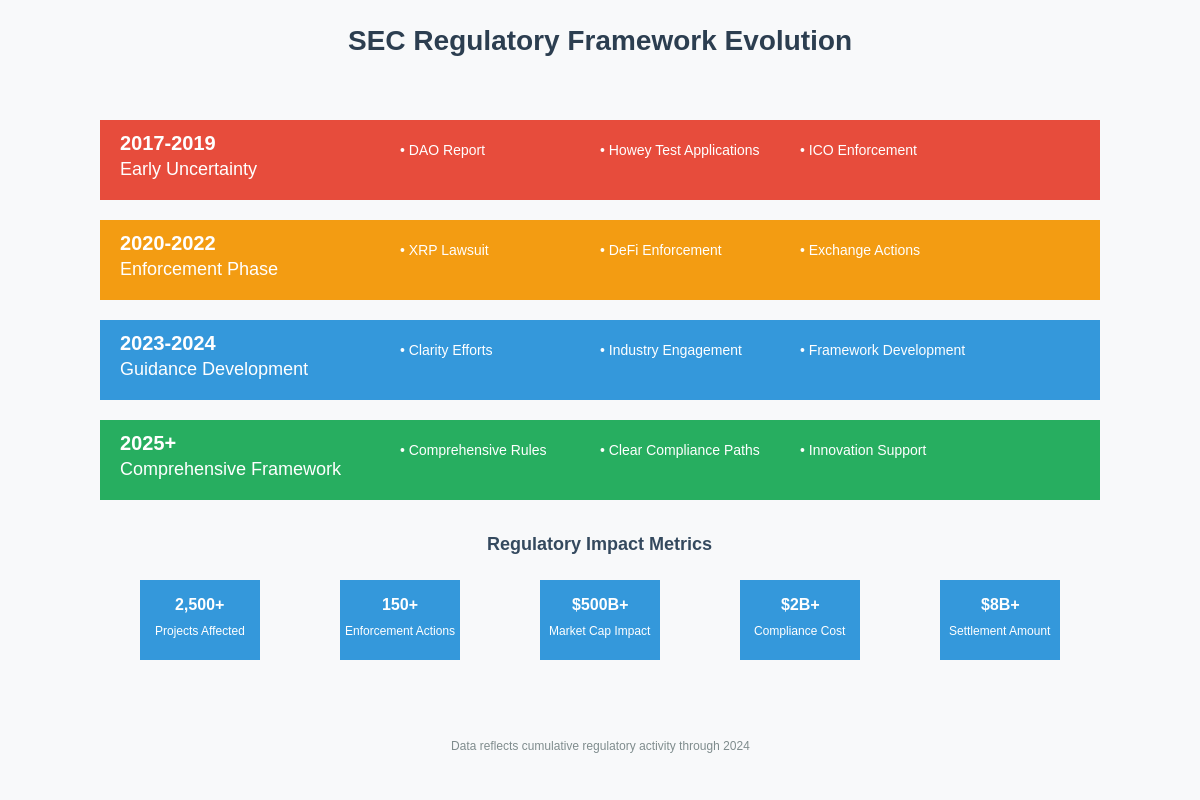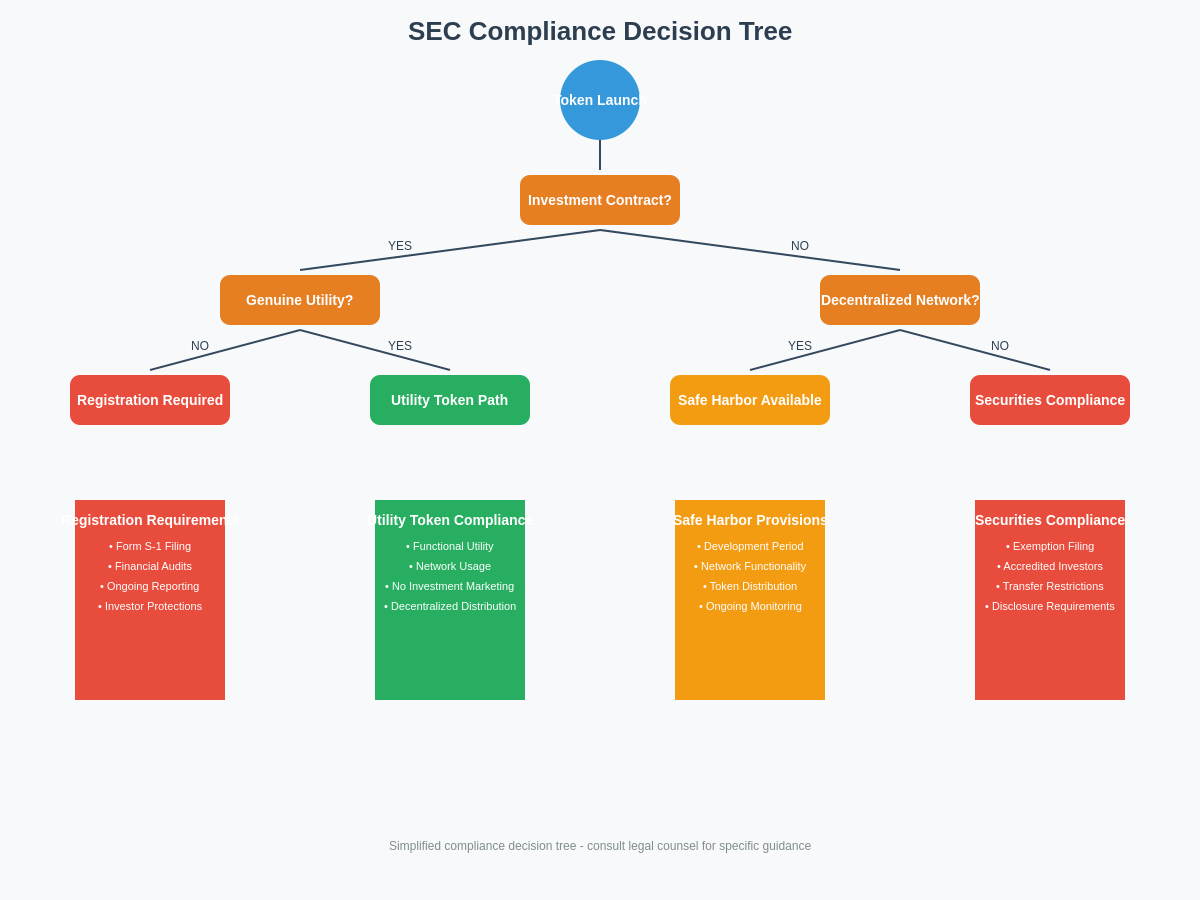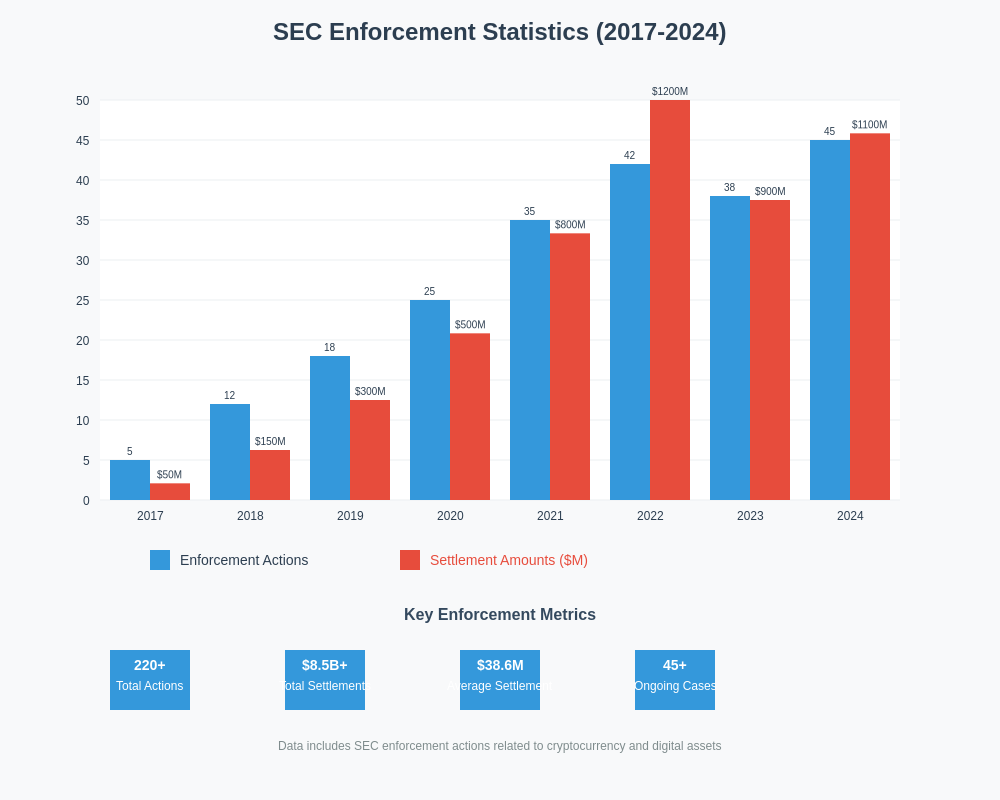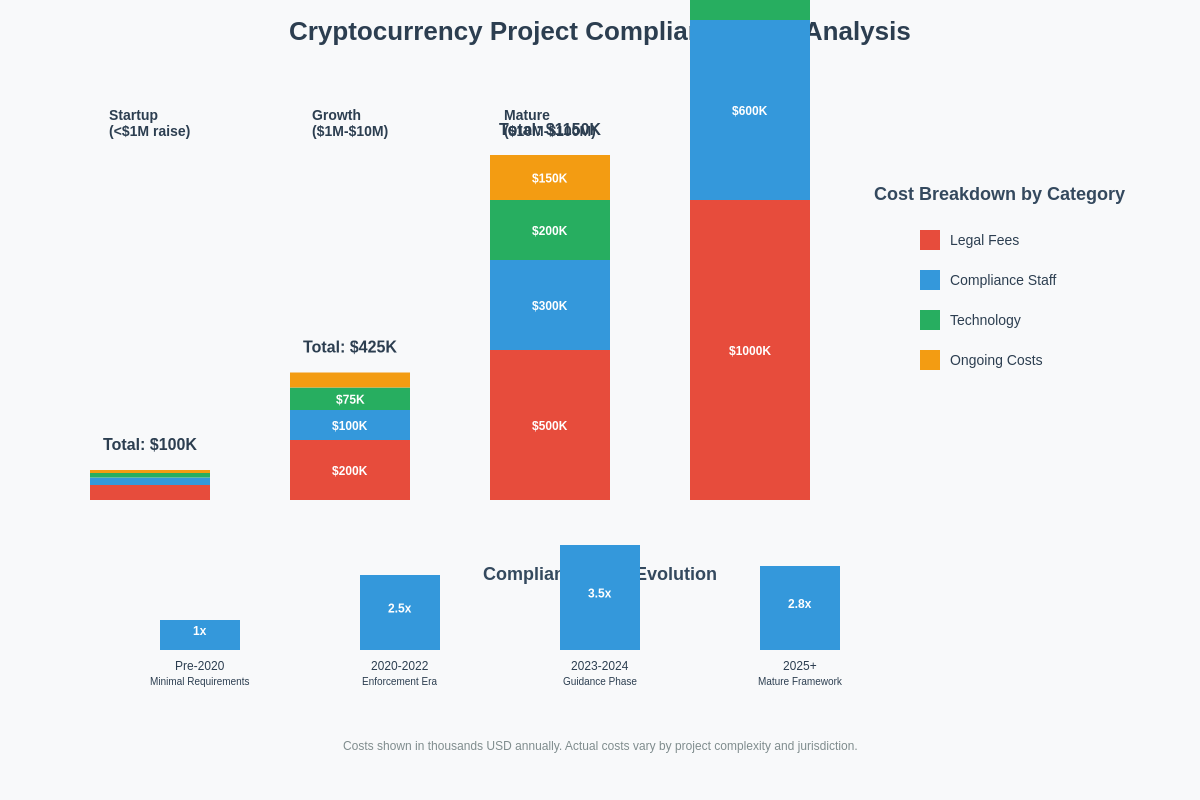The Securities and Exchange Commission has introduced comprehensive new guidelines that fundamentally reshape the regulatory landscape for cryptocurrency projects, establishing clearer frameworks for compliance while creating significant implications for token issuers, exchanges, and decentralized finance protocols. These updated regulatory frameworks represent the most significant development in cryptocurrency regulation since the agency began scrutinizing digital assets, providing long-awaited clarity while imposing stringent new requirements that will affect virtually every aspect of the cryptocurrency ecosystem.
Understanding the New Regulatory Framework
The Securities and Exchange Commission’s latest guidelines represent a comprehensive overhaul of how cryptocurrency projects must approach compliance, registration, and operational procedures within the United States market. These guidelines establish clear criteria for determining when digital assets constitute securities, outline specific requirements for token offerings, and provide detailed frameworks for ongoing compliance obligations that affect everything from smart contract deployment to community governance structures.

The new framework introduces a multi-tiered approach to cryptocurrency regulation that differentiates between various types of digital assets based on their characteristics, use cases, and distribution methods. Projects involving utility tokens with genuine functionality face different requirements than those issuing governance tokens, while securities-classified tokens must comply with traditional securities laws adapted for digital asset characteristics. This nuanced approach represents a significant evolution from previous regulatory uncertainty, though it also creates complex compliance obligations that require careful navigation.
Central to the new guidelines is the expanded application of the Howey Test to cryptocurrency projects, with the SEC providing detailed guidance on how courts and regulators will evaluate digital assets for securities classification. The guidelines clarify that decentralization alone does not exempt tokens from securities laws, particularly during initial distribution phases, and establish specific criteria for evaluating when ongoing promotional activities or development efforts might maintain securities classification even after initial distribution.
The guidelines also address the complex relationship between decentralized autonomous organizations and traditional corporate governance structures, establishing requirements for transparency, accountability, and regulatory compliance that must be maintained even within supposedly decentralized systems. This creates significant challenges for projects that have traditionally operated under assumptions of regulatory immunity based on decentralized structures.
Token Classification and Securities Determination
The new SEC guidelines provide unprecedented clarity regarding how digital assets will be evaluated for securities classification, establishing specific criteria that projects must consider during token design and distribution phases. The framework moves beyond simple application of existing securities laws to address unique characteristics of blockchain-based assets, including programmable functionality, decentralized distribution, and community governance mechanisms.

Under the updated framework, tokens that provide access to specific functionality within a blockchain network may avoid securities classification if they meet stringent requirements regarding genuine utility, decentralized distribution, and lack of investment expectations among purchasers. However, the guidelines make clear that utility claims must be substantiated by actual functionality rather than promised future development, creating immediate compliance obligations for projects with tokens that provide access to features still under development.
The guidelines establish a temporal approach to securities determination that recognizes tokens may change classification over time as networks mature and decentralize. Initially centralized projects that later achieve genuine decentralization may see their tokens transition from securities to non-securities status, though this transition requires documented evidence of decentralization across multiple dimensions including governance, development, and economic incentives.
Governance tokens face particularly complex evaluation under the new guidelines, with the SEC establishing criteria for determining when voting rights constitute investment contracts versus genuine participatory governance. Projects must demonstrate that token holders exercise meaningful control over project direction rather than simply ratifying decisions made by centralized development teams, requiring fundamental changes to how many decentralized finance protocols operate.
The guidelines also address staking mechanisms and their potential securities implications, establishing frameworks for evaluating when staking rewards constitute investment returns versus network participation incentives. Projects implementing proof-of-stake consensus mechanisms must carefully structure their reward systems to avoid creating investment contract relationships with token holders while maintaining network security incentives.
Registration Requirements and Exemptions
The new SEC guidelines establish comprehensive registration requirements for cryptocurrency projects while providing specific exemptions and safe harbors that enable compliant token distribution under certain circumstances. These requirements represent a significant departure from the regulatory uncertainty that previously characterized the cryptocurrency space, creating clear pathways for compliant token offerings while establishing severe penalties for non-compliance.
Projects seeking to distribute tokens that qualify as securities must now comply with traditional securities registration requirements adapted for digital asset characteristics, including detailed disclosure documents, financial reporting obligations, and ongoing compliance monitoring. The registration process has been streamlined for certain types of token offerings, though it still requires significant legal and compliance infrastructure that may be prohibitive for smaller projects.
The guidelines introduce new exemptions specifically designed for cryptocurrency projects, including provisions for genuinely decentralized networks, utility tokens with proven functionality, and community-driven governance tokens that meet specific criteria for democratic participation. These exemptions provide pathways for compliant token distribution without full securities registration, though they require ongoing compliance monitoring and detailed documentation of exemption eligibility.
Safe harbor provisions within the new guidelines allow projects to distribute tokens under certain circumstances while maintaining compliance with securities laws, including time-limited exemptions for network development, community building, and ecosystem bootstrapping activities. These provisions recognize the unique characteristics of blockchain networks that require token distribution to achieve functionality, though they impose strict limitations on promotional activities and investment marketing.
The guidelines also establish specific requirements for token pre-sales, private placements, and institutional distributions that must be satisfied regardless of subsequent public distribution methods. These requirements create complex compliance obligations for projects that engage in multi-phase token distribution strategies, requiring careful coordination between different distribution phases to maintain overall compliance.
Professional service providers including lawyers, accountants, and compliance consultants face new obligations under the guidelines to ensure their cryptocurrency clients maintain appropriate compliance standards. This creates additional due diligence requirements for projects while establishing professional liability for advisors who assist with non-compliant token distributions, fundamentally changing the risk profile for traditional professional services in the cryptocurrency space.
Exchange Listing and Trading Requirements
The updated SEC guidelines impose comprehensive new requirements on cryptocurrency exchanges operating within United States jurisdiction, establishing detailed frameworks for token listing procedures, trading oversight, and customer protection measures that significantly impact how digital assets reach retail and institutional investors. These requirements represent one of the most significant operational changes for cryptocurrency exchanges since their emergence, creating substantial compliance costs while potentially improving market integrity and investor protection.
Exchanges must now implement enhanced due diligence procedures for evaluating whether tokens qualify as securities before enabling trading, including ongoing monitoring obligations to detect changes in token classification status over time. This creates significant operational challenges for exchanges that have traditionally listed tokens with minimal regulatory analysis, requiring substantial investment in legal and compliance infrastructure to maintain operations within SEC guidelines.
The new framework establishes specific requirements for customer disclosures related to securities-classified tokens, including risk warnings, regulatory status notifications, and educational materials that must be provided before customers can trade certain types of digital assets. These disclosure requirements create additional friction in the customer onboarding process while potentially improving informed decision-making among retail investors.
Market surveillance obligations under the new guidelines require exchanges to implement sophisticated monitoring systems for detecting manipulation, insider trading, and other securities violations in cryptocurrency markets. These systems must be capable of analyzing blockchain transaction data, identifying suspicious trading patterns, and reporting potential violations to regulatory authorities, creating substantial technical and operational requirements for exchange operators.
The guidelines also establish specific requirements for custody and segregation of customer funds, mandating that exchanges maintain appropriate safeguards for both securities-classified and non-securities digital assets. These requirements may necessitate significant changes to existing custody infrastructure while creating additional operational costs for exchange operators who must maintain compliance across multiple asset classes.
International exchanges seeking to serve United States customers face particular challenges under the new guidelines, with specific requirements for regulatory coordination, compliance monitoring, and enforcement cooperation that may limit the ability of foreign platforms to serve American investors. This creates potential market fragmentation while establishing clearer boundaries for regulatory jurisdiction over cryptocurrency trading activities.
DeFi Protocol Compliance Obligations
Decentralized finance protocols face unprecedented regulatory scrutiny under the new SEC guidelines, with specific requirements addressing governance structures, token distribution mechanisms, and ongoing compliance obligations that challenge traditional assumptions about regulatory immunity for decentralized systems. These requirements represent a fundamental shift in how regulators approach decentralized protocols, establishing personal liability for developers and governance participants while creating complex compliance obligations for community-driven projects.
The guidelines establish criteria for evaluating when DeFi protocols must comply with securities laws despite their decentralized structure, focusing on factors including developer control, revenue distribution mechanisms, and the presence of investment expectations among token holders. Protocols that generate revenue for token holders through fees, yield farming, or other mechanisms face particular scrutiny under securities laws, requiring careful structuring to avoid regulatory violations.
Governance token issuers within DeFi protocols must now consider securities law implications when designing voting mechanisms, revenue sharing arrangements, and community governance structures. The guidelines make clear that decentralized governance does not automatically exempt projects from securities regulation, particularly when governance tokens provide rights to protocol revenues or when voting is concentrated among small groups of large token holders.
The new framework addresses automated market makers, lending protocols, and other DeFi primitives with specific guidance regarding how these systems may trigger securities law obligations depending on their structure and operation. Protocols that automatically compound returns, distribute trading fees to liquidity providers, or implement complex tokenomics models must carefully evaluate their compliance obligations under the expanded regulatory framework.
Developer liability represents a particularly significant concern under the new guidelines, with specific provisions establishing potential personal responsibility for protocol operators who fail to maintain appropriate compliance standards. This creates substantial personal risk for DeFi developers while potentially discouraging innovation in decentralized finance systems that have traditionally operated without regulatory oversight.
The guidelines also address cross-protocol composability and its regulatory implications, establishing frameworks for evaluating compliance obligations when DeFi protocols interact with other systems that may have different regulatory classifications. This creates complex compliance challenges for protocols that integrate with multiple other systems while establishing potential liability for facilitating transactions that may violate securities laws.
Disclosure and Reporting Obligations
The new SEC guidelines establish comprehensive disclosure and reporting requirements for cryptocurrency projects that significantly expand transparency obligations while creating ongoing compliance costs for token issuers and protocol operators. These requirements represent a substantial shift toward traditional securities-style disclosure regimes adapted for digital asset characteristics, requiring projects to provide detailed information about operations, finances, governance, and risk factors that may affect token holders.
Initial disclosure requirements mandate that projects provide comprehensive information about token economics, distribution mechanisms, use of proceeds, development roadmaps, and material risks associated with token ownership or protocol participation. These disclosures must be updated regularly to reflect changing circumstances, technological developments, and material events that may affect token value or protocol functionality, creating ongoing compliance obligations that extend well beyond initial token distribution phases.
Financial reporting requirements under the new guidelines establish specific accounting standards for cryptocurrency projects, including treatment of token holdings, revenue recognition from protocol fees, and valuation methodologies for digital assets held by projects or protocols. These accounting standards create substantial compliance costs while requiring projects to maintain traditional corporate financial infrastructure alongside blockchain-based operations.
The guidelines also establish specific requirements for disclosing governance structures, decision-making processes, and the relationship between token holders and project developers or protocol operators. Projects must provide clear information about how governance decisions are made, what rights token holders possess, and how conflicts of interest are managed within decentralized governance systems.
Material event reporting requirements mandate that projects promptly disclose significant developments including security incidents, major partnership agreements, regulatory changes, and technological developments that may affect token value or protocol operations. These reporting obligations create ongoing monitoring requirements while establishing potential liability for projects that fail to disclose material information in a timely manner.
The new framework also addresses cross-border reporting obligations for projects that operate internationally while serving United States investors, establishing specific requirements for coordination with foreign regulators and compliance with multiple regulatory regimes simultaneously. This creates complex compliance challenges for global cryptocurrency projects while potentially limiting the ability of foreign projects to serve American investors.
Penalties and Enforcement Mechanisms
The updated SEC guidelines establish a comprehensive enforcement framework with significantly enhanced penalties for cryptocurrency projects that fail to comply with securities laws, representing a dramatic escalation in regulatory enforcement capabilities while creating substantial risk for non-compliant projects and their operators. These enforcement mechanisms include both civil and criminal penalties that can result in substantial financial liability, operational restrictions, and personal consequences for project leaders and developers.

Civil penalties under the new framework can reach millions of dollars for significant violations, with specific calculation methodologies that consider factors including the amount of funds raised, the number of investors affected, and the degree of harm caused by regulatory violations. These penalties can be imposed on both projects and individuals, creating personal liability for developers, executives, and governance participants who participate in non-compliant activities.
The guidelines establish specific enforcement priorities that focus on projects with significant investor harm, fraudulent activities, or systematic regulatory evasion, while providing more lenient treatment for projects that demonstrate good faith compliance efforts and cooperate with regulatory investigations. This creates incentives for projects to engage proactively with regulators while establishing clear consequences for those who attempt to avoid regulatory oversight.
Criminal referral mechanisms within the new framework enable the SEC to coordinate with Department of Justice prosecutors on cases involving intentional securities law violations, fraud, or other criminal conduct related to cryptocurrency projects. These referrals can result in criminal charges including imprisonment for individuals who knowingly violate securities laws or engage in fraudulent conduct related to token offerings or protocol operations.
The enforcement framework also includes specific provisions for international cooperation and cross-border enforcement actions, enabling coordination with foreign regulators to pursue enforcement actions against projects or individuals who attempt to evade United States jurisdiction. This international cooperation capability significantly expands the SEC’s enforcement reach while creating risks for projects that attempt to structure operations to avoid United States regulatory oversight.
Industry-wide enforcement initiatives under the new guidelines enable coordinated action against multiple projects or market participants simultaneously, creating the potential for systematic enforcement sweeps that could affect large numbers of cryptocurrency projects operating in similar regulatory grey areas. These initiatives can result in industry-wide compliance changes while establishing precedents that affect regulatory interpretation for all cryptocurrency projects.
International Coordination and Cross-Border Compliance
The new SEC guidelines establish comprehensive frameworks for international regulatory coordination that recognize the global nature of cryptocurrency markets while asserting United States regulatory jurisdiction over activities that affect American investors. These frameworks create complex compliance obligations for international projects while establishing mechanisms for cooperation between United States and foreign regulators on enforcement actions, information sharing, and coordinated policy development.
Cross-border compliance requirements under the new guidelines mandate that foreign cryptocurrency projects serving United States investors implement appropriate compliance measures regardless of their home jurisdiction regulatory status. This creates significant operational challenges for international projects while potentially limiting market access for projects that cannot meet United States compliance requirements, fundamentally altering the global competitive landscape for cryptocurrency projects.
The guidelines establish specific procedures for regulatory cooperation between the SEC and foreign financial regulators, including information sharing agreements, coordinated enforcement actions, and harmonized policy development initiatives. These cooperation mechanisms enable more effective oversight of global cryptocurrency markets while creating potential conflicts when different jurisdictions have incompatible regulatory approaches or enforcement priorities.
Jurisdictional determination frameworks within the new guidelines provide specific criteria for evaluating when the SEC has authority over cryptocurrency projects or activities that occur partially outside United States territory. These frameworks focus on factors including the location of investors, the use of United States financial infrastructure, and the targeting of marketing activities toward American investors, creating complex compliance obligations for projects with international operations.
The new framework also addresses regulatory arbitrage concerns by establishing specific requirements for projects that attempt to structure operations to avoid United States regulatory oversight while still serving American investors. These anti-avoidance provisions create significant compliance risks for projects that engage in regulatory shopping while establishing clear boundaries for acceptable international structuring strategies.
Treaty obligations and international legal frameworks play an increasingly important role under the new guidelines, with specific provisions addressing how existing mutual legal assistance treaties, extradition agreements, and regulatory cooperation frameworks apply to cryptocurrency enforcement actions. This creates additional legal complexity for international projects while expanding the SEC’s ability to pursue enforcement actions against foreign entities and individuals.
Technology and Smart Contract Considerations
The new SEC guidelines address the unique technological characteristics of blockchain-based systems and smart contracts, establishing specific compliance requirements for programmable financial instruments while recognizing the challenges of applying traditional securities regulation to automated systems. These technological considerations represent one of the most innovative aspects of the new framework, adapting securities law concepts to address immutable code, algorithmic governance, and decentralized execution systems.
Smart contract compliance requirements under the new guidelines mandate that projects implement appropriate safeguards and compliance mechanisms directly within their code, including automated disclosure systems, transaction monitoring capabilities, and compliance checking functions that operate at the protocol level. This creates substantial technical challenges for developers while requiring integration of legal compliance requirements directly into blockchain-based systems.
The guidelines establish specific requirements for smart contract auditing and security assessments that must be completed before deployment of systems that may trigger securities law obligations. These assessments must evaluate not only technical security considerations but also regulatory compliance aspects of smart contract functionality, requiring coordination between technical auditors and legal compliance specialists.
Immutability challenges receive specific attention within the new framework, with provisions addressing how projects must handle compliance obligations when smart contracts cannot be modified after deployment. The guidelines establish requirements for governance mechanisms, upgrade procedures, and emergency response capabilities that must be implemented before deployment to ensure ongoing compliance capability even within immutable systems.
The new framework also addresses algorithmic governance and its regulatory implications, establishing criteria for evaluating when automated decision-making systems trigger securities law obligations or create compliance challenges. Projects implementing algorithmic governance must demonstrate that their systems maintain appropriate human oversight and compliance capabilities while achieving their intended automation benefits.
Cross-chain interoperability and its regulatory implications receive detailed treatment within the new guidelines, establishing frameworks for evaluating compliance obligations when smart contracts interact across multiple blockchain networks with potentially different regulatory classifications. This creates complex compliance challenges for projects that implement cross-chain functionality while establishing clear requirements for maintaining compliance across multiple technological platforms.
Impact on Innovation and Market Development
The implementation of comprehensive SEC guidelines creates significant implications for innovation within the cryptocurrency space, establishing new compliance costs and operational requirements that may affect the pace and direction of technological development while potentially improving market stability and investor protection. These impacts represent a fundamental shift in the risk-reward calculation for cryptocurrency innovation, creating both challenges and opportunities for projects operating within the new regulatory framework.

Startup cryptocurrency projects face substantially increased barriers to entry under the new guidelines, with compliance costs and regulatory complexity that may be prohibitive for early-stage companies without substantial legal and compliance resources. This creates potential consolidation pressure within the industry while potentially slowing the pace of innovation as resources are diverted from development to compliance activities.
The guidelines may encourage development of more compliant-by-design cryptocurrency systems that incorporate regulatory requirements directly into their technological architecture, potentially leading to innovation in regulatory technology and automated compliance systems. This could result in new categories of blockchain-based tools designed specifically to help projects maintain compliance with securities laws while achieving their technical objectives.
Investment patterns within the cryptocurrency space are likely to shift significantly under the new regulatory framework, with institutional investors potentially becoming more comfortable with compliant projects while retail investors may face reduced access to certain types of token offerings. This could result in market stratification with different tiers of projects serving different investor categories under different regulatory frameworks.
The international competitiveness of United States-based cryptocurrency projects may be affected by the new compliance requirements, with projects potentially relocating operations to jurisdictions with more favorable regulatory environments while still serving global markets. This creates potential risks for United States leadership in cryptocurrency innovation while establishing clearer competitive boundaries between different regulatory jurisdictions.
Long-term market development may be positively affected by increased regulatory clarity, with improved investor confidence and institutional adoption potentially offsetting short-term compliance costs and operational challenges. The guidelines may ultimately result in a more mature and stable cryptocurrency market that can better serve both institutional and retail investors while maintaining appropriate consumer protections.
Future Regulatory Developments and Industry Adaptation
The new SEC guidelines represent just the beginning of comprehensive cryptocurrency regulation, with additional regulatory developments expected from other federal agencies, state regulators, and international bodies that will further shape the compliance landscape for cryptocurrency projects. Industry participants must prepare for continued regulatory evolution while building compliance infrastructure that can adapt to changing requirements over time.
Anticipated regulatory developments include additional guidance from the Commodity Futures Trading Commission regarding commodity classification of digital assets, Treasury Department regulations addressing anti-money laundering requirements for decentralized systems, and Federal Reserve policies regarding central bank digital currencies and their interaction with private cryptocurrency projects. These additional regulatory frameworks will create complex compliance obligations requiring coordination across multiple regulatory regimes.
Industry adaptation strategies are emerging as projects begin implementing compliance systems designed to meet current requirements while maintaining flexibility for future regulatory changes. These strategies include modular compliance architectures, automated monitoring systems, and governance structures that can accommodate evolving regulatory requirements without requiring fundamental changes to project operations.
The development of regulatory technology specifically designed for cryptocurrency compliance represents a growing market opportunity, with specialized service providers emerging to help projects navigate complex compliance requirements while maintaining operational efficiency. These service providers may become critical infrastructure for the cryptocurrency industry as regulatory requirements continue to evolve and become more sophisticated.
International regulatory harmonization efforts are likely to accelerate as different jurisdictions seek to address cross-border cryptocurrency activities while avoiding regulatory fragmentation that could harm market development. These harmonization efforts may result in convergence toward common regulatory standards while maintaining jurisdiction-specific requirements that reflect different policy priorities and legal frameworks.
Industry self-regulation initiatives may also play an increasingly important role as projects seek to demonstrate good faith compliance efforts while influencing the development of future regulatory requirements. These initiatives could include industry standards for security practices, compliance procedures, and consumer protection measures that exceed minimum regulatory requirements while establishing best practices for the broader cryptocurrency community.
Disclaimer
This article is for informational purposes only and does not constitute legal, financial, or investment advice. The SEC guidelines discussed are complex and continue to evolve. Cryptocurrency projects should consult with qualified legal and compliance professionals to understand their specific regulatory obligations. The regulatory landscape for cryptocurrency is rapidly changing, and compliance requirements may vary based on specific project characteristics and operations. This article does not guarantee compliance with applicable laws or regulations.